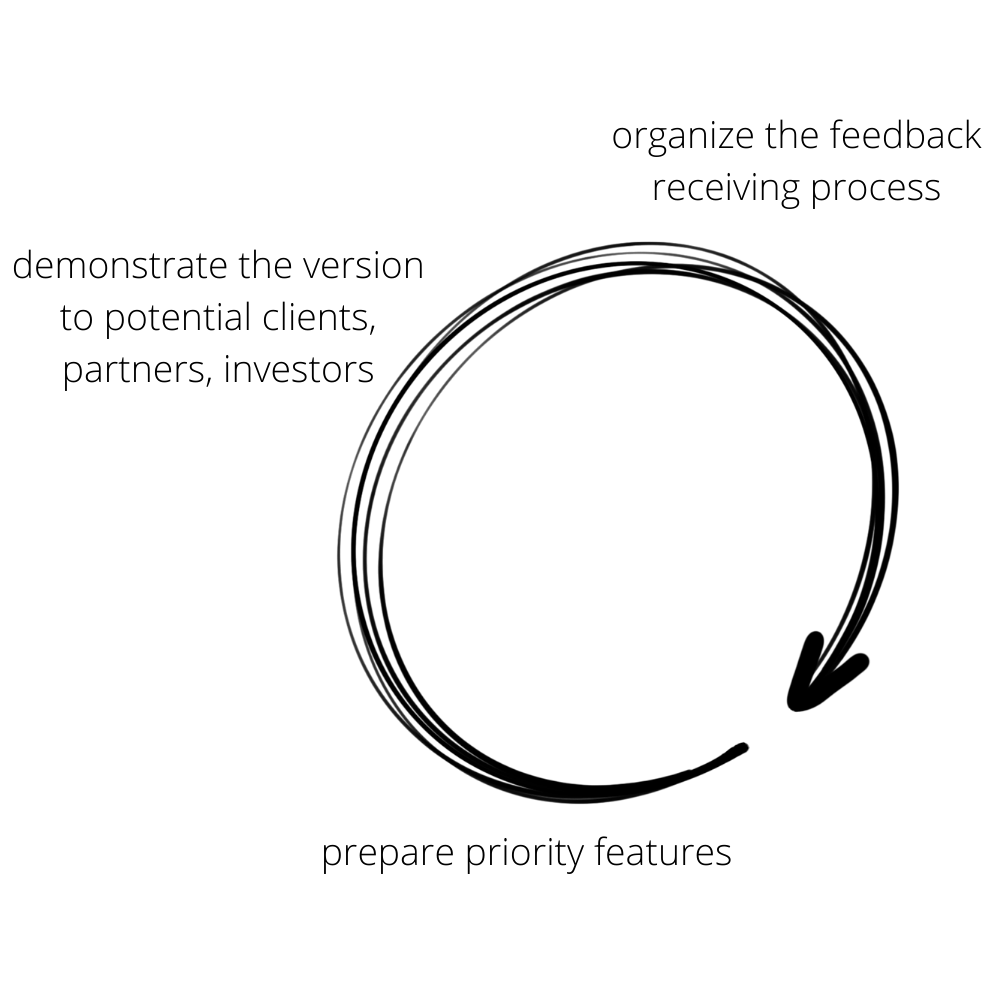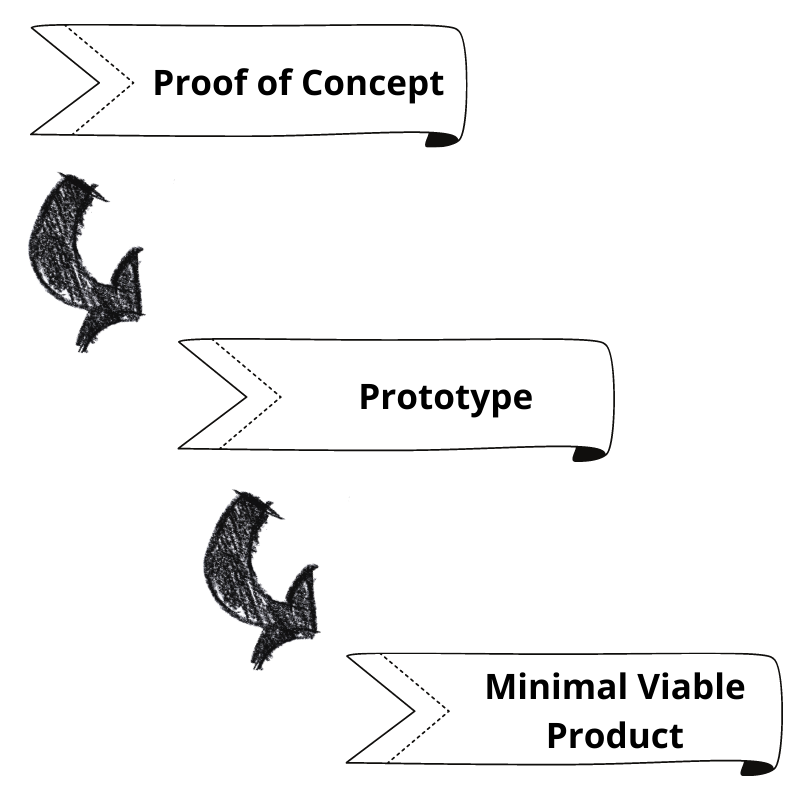Content
Implementation of a new business idea is not an easy task in the modern world. It’s not just a challenging competitive situation exacerbated by the pandemic. Lack of resources, no understanding of the goal by the team, overestimation of their capabilities, rejection of the idea by the audience…
There are thousands of reasons why companies have problems organizing product development and promoting software ideation on the market. These failures may be avoided by validating the concept timely, developing an early model, and testing the idea on the first clients. In this article, we will analyze 3 strategies that will help you create a promising product.
Proof of Concept: is the idea technically feasible?
Working on an innovative project is always connected with uncertainty. Even if the new concept seems workable, it’s worth checking it out anyway. And Proof Of Concept (POC) is one way to do it. This approach allows testing the concept (technology, method, integration) for feasibility from a technical point of view before product development.
POC is not a full-fledged product but a computer model, a prototype that allows you to evaluate the possibility of development. To create it, it’s unnecessary to focus on the quality and safety of the code, design, and interface. It is based on programmed data, APIs, etc.
The POC will not be reused or shown to the audience. The results obtained during the testing process are helpful for internal application and knowledge exchange between team members. It allows you to decide on the development or termination of the project or the introduction of new technologies. And if you prove that the project works, you can attract investors for seed funding.
How to work on a Proof of Concept:
- Set a goal and features that may complicate custom software development.
- Make a list of scenarios of how real users of a web or mobile application may act.
- Distribute tasks for 3-4 weeks (each week = 1 iteration) so that everything is fast and with no unnecessary investments.
- Engage the developer, QA, and PM. It will allow you to assess the technical capabilities for implementing the solution ideation.
- Make a decision based on the results: if there are bottlenecks and risk zones in the project, look for alternatives.

These steps allow you to eliminate the risks and determine if your product is feasible in the current environment. Imagine how much you will lose if you assemble a team, build a strategy, organize a software development process… and in the middle of the way, you realize that your project is not profitable. The transition to other concepts will be longer and more painful due to limited budget and self-doubt. Isn’t it easier to avoid this?
How POC contributes to product success:
- Makes innovation attractive to investors who only trust proven projects.
- Shows errors at an early project stage.
- Reduces the cost of creating the functionality, cutting off features that cannot be implemented.
- Eliminates doubts. There are only 2 answers to the question “is it realistic to create a product?”: Yes or no.
Another advantage of the approach is its versatility. Do you want to patent technology, for example, in the real-time development field? To verify the non-standard method of mobile application development? To scale production based on a new concept? Or to attract funding at the first stage of working with a product? Proof of concept will be the first step in minimizing risks in development.

Prototyping: what will the finished product look like?
Let’s say you understand that a new concept has the right to be implemented. It’s time to pay attention to visuals and navigation to create a convenient product following users’ needs. You can’t do it without a prototype. The solution prototype is the “skeleton” of the finished project, an interactive model that allows you to see the product in action before its creation.
How to work on a software prototype:
- Study the market and find out from the target audience what requirements it has for such programs.
- Prepare a version that includes priority features for the audience.
- Demonstrate the prepared version to potential clients, partners, and investors.
- Organize the feedback and opinions receiving process and adjust or completely revise the strategy.
- Repeat steps based on received data from potential users, create the interface of all screens and check the behavior of elements.

When may a solution prototype be considered successful? When the result suits all project participants. For example, when it comes to an application prototype, the results should be negotiated with potential customers and your mobile application development team that improves product design and cares about the user experience. As a result, the app prototype helps you see the solution in real time from the point of view of future users and ensure the ideation quality.
A prototype allows you to:
- Find out what users think about product design and navigation and focus on what’s important.
- Identify imperfections in the early stages of the development process and plan bug fixes.
- Reduce the probability of financial risks and failure to meet the deadline
- Simplify project management and distribution of tasks within the team.
Since this approach has several variations, it is optimal for projects with a limited budget and time. You can redo the model from scratch based on new reviews (Rapid). Or you can gradually improve one version (Evolutionary) or divide the project into parts (Incremental). There is also a method for web application development (Extreme). The Prototype strategy makes the transition to MVP much easier.

Minimal Viable Product: Does the audience need a product?
It has long been proven that the lion’s share of unsuccessful ventures in business is associated with exaggerating the benefits of your idea for the audience. According to Startuphulk, 43% of newbies burn out because their product has no value for potential users. So, your idea may be simple in terms of development, and the app seems to be super quality, but that does not mean that the audience will choose you.
The Minimal Viable Product (MVP) concept helps you avoid such situations and accurately assess your opportunities in the market. It is a working product ready for release. It has a limited set of functions (sometimes even one). The main thing is that these functions are valuable for the audience and solve critical tasks.
The purpose of this approach is to find out the opinion of potential customers about the product and understand whether it is worth developing. Based on actual users, you can decide what changes need to be made to the project and what should be left as is.
How to do MVP software development:
- Narrow your audience by creating a portrait of a user who will choose your product without hesitation.
- Identify the main pains and needs of the target audience and turn them into tasks to be solved.
- Compose various custom scenarios to understand the approximate customer journey.
- Prioritize features based on their importance to your industry and audience.
- Establish your development process to regularly update custom software and web projects and add features to the app promptly.
- Test the Minimal Viable Product engaging its future users.

With the MVP approach, you will find out the demand for your efforts. Further, it all depends on the desire to modify the project and adapt it for users. Testing should continue throughout the custom software development and be performed by both Quality assurance engineers and first users. Then the result won’t disappoint you.
Why MVP is critical for product success:
- More value for potential customers and increased chances of a sale.
- Setting the right development course, and attracting sponsors.
- Reduced risks associated with misunderstanding the situation in the industry and overestimating your resources.
- Simple software development process and cost planning.
The result of the Minimal Viable Product is a technically perfect solution with competitive functions and access to the big world. Many well-known companies did it: Amazon, Dropbox, Foursquare, Groupon, Zappos, Facebook… All of them managed to become big players because they developed based on user feedback. This approach is valuable for all startups looking to generate profits and attract customers quickly.

POC vs. MVP vs. Prototype
- Proof Of Concept. Used internally by the team to determine technical feasibility. No income. It requires some investments and allows attracting internal financing.
- Prototype. Used for demonstrating to interested parties to check the design and navigation. No income. Requires a minimum investment.
- Minimal Viable Product. Used for a narrow target audience to test features and find out the demand. Income from first customers is possible. Requires enough investment but is cost-effective.

Instead of a conclusion, or universal scaling model
Did you pay attention to the order of items? These approaches can be used together in this sequence to create a product. We consider the “from POC to Prototype to MVP” model to be the best for any ideas: custom software for business, mobile development, or web application development. You don’t need to choose between 3 strategies. You can use all the benefits described and consistently remove barriers until you achieve success. And we will help you with this! Contact AdvantISS for more detail!





